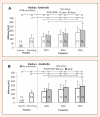The effect of whole-body vibration frequency and amplitude on the myoelectric activity of vastus medialis and vastus lateralis
- PMID: 24149311
- PMCID: PMC3737908
The effect of whole-body vibration frequency and amplitude on the myoelectric activity of vastus medialis and vastus lateralis
Abstract
The aim of this study was to evaluate the efficiency of training protocols for whole body vibration (WBV) training through the modulation of the frequency and amplitude of vibration. Despite the large number of studies regarding effects of such training, there is still lack of knowledge regarding optimum training protocols. The study analyzed the influence of whole-body vibration parameters (i.e., the frequency and amplitude) on the myoelectric activity of vastus lateralis and vastus medialis in 29 females with the use of electromyography (EMG). The first and second of the eight consecutive trials were performed without vibrations; the remaining six trials were performed in a randomized order on a platform vibrating at different amplitude (2mm and 4mm) and frequency (20 Hz, 40 Hz and 60 Hz) combinations. The results revealed significantly higher EMG amplitude of both muscles during the vibration as compared with the non- vibrated trials (trial 1 and 2). Furthermore, the EMG activity significantly increased both with the amplitude and frequency, being the highest when the frequency and amplitude of reached 60 Hz and 4 mm, respectively. The study aims to determine the optimal vibration parameters in the aspect of purposeful stimulation of chosen leg muscles. Based on the results of the presented investigation, sports trainers and physiotherapists may be able to optimize training programs involving vibration platforms. Key pointsThe observed vibration effect significantly increases both with the amplitude and frequency.Certain frequency/amplitude combinations of mechanical vibrations cause the same level of myoelectric muscle activity.
Keywords: EMG; muscle activity; vibration training; whole body vibration (WBV).
Figures

Similar articles
-
Effects of whole-body vibration training in static and dynamic semi-squat patterns on the lower limb muscle activity.Sci Rep. 2023 Sep 2;13(1):14432. doi: 10.1038/s41598-023-40985-x. Sci Rep. 2023. PMID: 37660154 Free PMC article.
-
Electromyography activity of vastus lateralis muscle during whole-body vibrations of different frequencies.J Strength Cond Res. 2003 Aug;17(3):621-4. doi: 10.1519/1533-4287(2003)017<0621:eaovlm>2.0.co;2. J Strength Cond Res. 2003. PMID: 12930196 Clinical Trial.
-
Whole-Body Vibration on Performance of Quadriceps After ACL Reconstruction: A Blinded Randomized Controlled Trial.J Sport Rehabil. 2019 Jan 1;28(1):52-58. doi: 10.1123/jsr.2017-0063. Epub 2018 Oct 1. J Sport Rehabil. 2019. PMID: 28872396 Clinical Trial.
-
The effects of whole-body vibration on upper- and lower-body EMG during static and dynamic contractions.Appl Physiol Nutr Metab. 2007 Dec;32(6):1156-63. doi: 10.1139/H07-116. Appl Physiol Nutr Metab. 2007. PMID: 18059590
-
Vibration detection: its function and recent advances in medical applications.F1000Res. 2020 Jun 17;9:F1000 Faculty Rev-619. doi: 10.12688/f1000research.22649.1. eCollection 2020. F1000Res. 2020. PMID: 32595943 Free PMC article. Review.
Cited by
-
Variations in neuromuscular activity of thigh muscles during whole-body vibration in consideration of different biomechanical variables.J Sports Sci Med. 2013 Sep 1;12(3):439-46. eCollection 2013. J Sports Sci Med. 2013. PMID: 24149149 Free PMC article.
-
The effect of a single session of whole-body vibration training in recreationally active men on the excitability of the central and peripheral nervous system.J Hum Kinet. 2014 Jul 8;41:89-98. doi: 10.2478/hukin-2014-0036. eCollection 2014 Jun 28. J Hum Kinet. 2014. PMID: 25114735 Free PMC article.
-
Whole-Body Vibration Exercise in Different Postures on Handgrip Strength in Healthy Women: A Cross-Over Study.Front Physiol. 2021 Jan 12;11:469499. doi: 10.3389/fphys.2020.469499. eCollection 2020. Front Physiol. 2021. PMID: 33536927 Free PMC article.
-
Effects of Whole-Body Vibration Therapy on Quadriceps Function in Patients With Anterior Cruciate Ligament Reconstruction: A Systematic Review.Sports Health. 2022 Mar-Apr;14(2):216-226. doi: 10.1177/19417381211004937. Epub 2021 Apr 5. Sports Health. 2022. PMID: 33813953 Free PMC article.
-
The effect of a short-term and long-term whole-body vibration in healthy men upon the postural stability.PLoS One. 2014 Feb 10;9(2):e88295. doi: 10.1371/journal.pone.0088295. eCollection 2014. PLoS One. 2014. PMID: 24520362 Free PMC article. Clinical Trial.
References
-
- Bosco C., Cardinale M., Tsarpela O. (1999) Influence of vibration on mechanical power and electromyogram activity in human arm flexor muscles. European Journal of Applied Physiology 79, 306-311 - PubMed
-
- Bosco C., Iacovelli M., Tsarpela O., Cardinale M., Bonifazi M., Tihanyi J., Viru M., De Lorenzo A., Viru A. (2000) Hormonal responses to whole-body vibration in men. European Journal of Applied Physiology 81, 449-454 - PubMed
-
- Cardinale M., Lim J. (2003) Electromyography activity of vastus lateralis muscle during whole-body vibrations of different frequencies. The Journal of Strength and Conditioning Research 17, 621-624 - PubMed
-
- Cardinale M., Bosco C. (2003) The use of vibration as an exercise intervention. Exercise and Sport Sciences Reviews 31(1), 3-7 - PubMed
LinkOut - more resources
Full Text Sources
